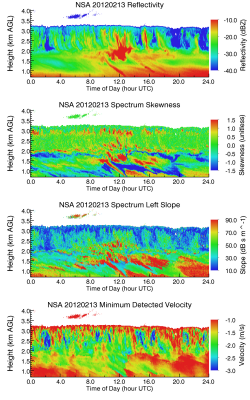New MICROARSCL Evaluation Data Released for Barrow, Alaska
Published: 23 January 2015

A new evaluation release of 18 months of data from Barrow, Alaska, provides the first KAZR-based Micro-Active Remote Sensing of Clouds (MICROARSCL) data from this North Slope of Alaska (NSA) site. The addition of the KAZR data to the NSA site adds temporal and spatial resolution relative to the retired millimeter wavelength cloud radar (MMCR). The improved resolution provided from the KAZR also diminishes spectral artifacts in the data, which provides more accurate information on cloud dynamics. This announcement follows a mid-2014 release that offered a mix of five years of data from the Southern Great Plains and Tropical Western Pacific sites and the Clouds, Aerosol, and Precipitation in the Marine Boundary Layer (CAP-MBL) campaign ARM Mobile Facility deployment in the Azores.
Since 2004, the ARM Climate Research Facility has established the continuous recording of profiling radar Doppler spectra. The recorded spectra offer a powerful means for overcoming the dependency of radar measurements on particle size (proportional to the sixth power of particle diameter), thus enabling the identification of both small and large particle populations in a radar sampling volume. This advances the ability to study and understand the microphysical and dynamical processes underlying the production and evolution of hydrometeors in clouds and precipitation.
While direct observations of radar Doppler spectra sometimes hold the key to new insight, it is often more useful to work with spectra indirectly through their extended moments (e.g., skewness and kurtosis) and other parameters that compactly capture the shape and complexity of their information. This is the purpose of the new value-added product (VAP) MICROARSCL currently under evaluation. This new VAP contains a familiar name—Active Remote Sensing of Clouds—but with a host of new complementary parameters to facilitate process studies down to the micro-scale.
Feedback and use of the data are welcomed and encouraged. For questions or to report data problems, please contact Mike Jensen or Ed Luke. To access this data sets, browse the ARM Data Archive. (Go here to request an account).
The ARM Climate Research Facility is a DOE Office of Science user facility. The ARM Facility is operated by nine DOE national laboratories, including .
Keep up with the Atmospheric Observer
Updates on ARM news, events, and opportunities delivered to your inbox
ARM User Profile
ARM welcomes users from all institutions and nations. A free ARM user account is needed to access ARM data.


















